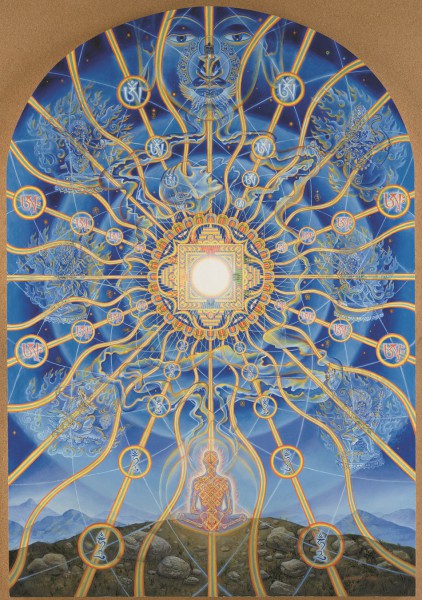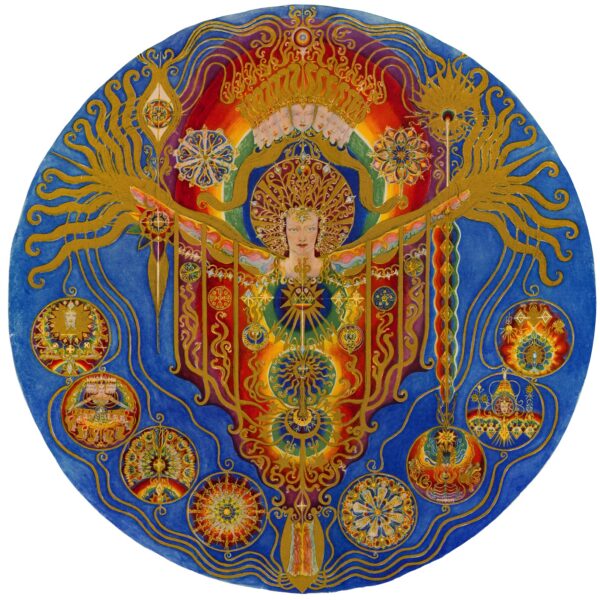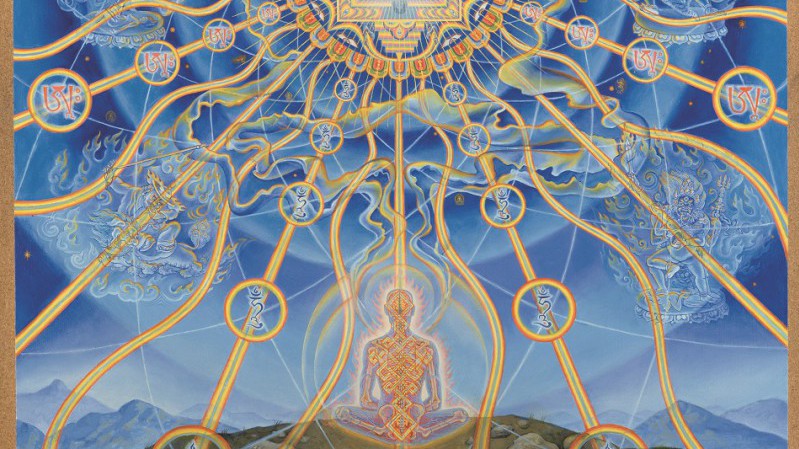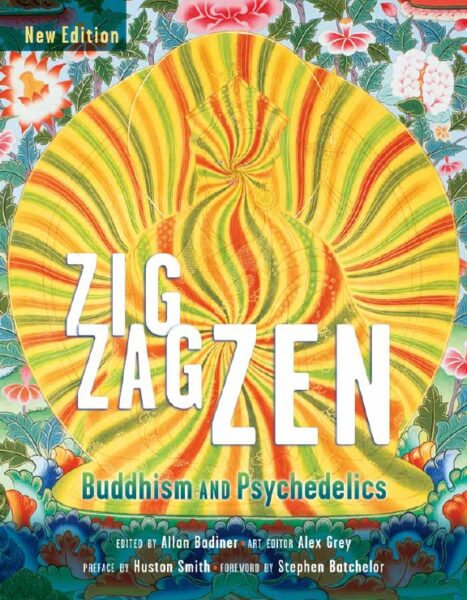
Nature of Mind (Panel 4) by Alex Grey, featured in the new edition of Zig Zag Zen: Buddhism and Psychedelics
This passage was taken from the essay “Vajravision” by Alex Grey in the new edition of Zig Zag Zen: Buddhism and Psychedelics
Startlingly clear inner visions often accompany our most profound and memorable meditative or psychedelic experiences. Distributed throughout Zig Zag Zen are images by extraordinary artists, offered to help visually contextualize the complex subject of the relationships between psychedelics and Buddhism. Some of the artists appearing in this volume have never done drugs, and some of these artists have probably never meditated. Nevertheless, their work is relevant to the themes of liberation of the mind, “altered states,” and depictions of transcendental emptiness, and includes nontraditional images of the Buddha or Buddhist-influenced iconography. The works of Odilon Redon, Mark Rothko, Ethel Le Rossignol, Francesco Clemente, Mati Klarwein, Ed Paschke, Robert Beer, Paul Laffoley, Michael Newhall, Mariko Mori, Ang Tsherin Sherpa, Robert Venosa, Dean Chamberlain, Luke Brown, Amanda Sage, Carey Thompson, Android Jones, Randal Roberts, Suhki Barber and Fred Tomaselli as well as pieces by my wife, Allyson Grey, and myself are woven throughout the pages of this book. Also presented are select examples from the Japanese Zen and Tibetan thangka traditions of Buddhist art. The connections and resonances between these diverse works are a quality of artistic consciousness I call Vajravision.
Perhaps one of the primary benefits of psychedelics is their capacity to make the subtle realms explicit. . .
The vajra is a spiritual tool, a thunderbolt scepter owned by the Hindu god Indra. It was adopted by the Buddhist sages as a symbol of the diamond-like clarity and brilliance of the mind’s true nature, and has come to stand for a special class of Buddhist teachings. These are known as the Vajrayana, which incorporate complex visualizations of deities, Buddhas, gurus, and sky-dancing dakinis. During carefully prescribed meditations, an exchange of transforming and enlightening energies takes place between the practitioner and the intensely imagined spiritual archetypes. Accomplishment in the Vajrayana approach depends on developing proficiency in opening the wisdom eye, navigating the subtle visionary realms, and confirming their luminosity, emptiness, and truth. Vajravision helps us see beyond the opaque material world to the spiritual reality behind appearances. A dependable way to introduce one’s self to the brightly colored and minutely articulated visionary inner worlds, to “see” with Vajravision, is through an entheogenic or psychedelic experience. Perhaps one of the primary benefits of psychedelics is their capacity to make the subtle realms explicit and inescapable to the percipient under their influence. To a consciousness familiar only with perception of the gross physical world, an immersion in the dynamic, overwhelming, and uncontrollable visionary imagination may result in ontological panic. Fear and paranoia then become infinitely magnified to hell-realm proportions; the classic “bad trip.” But given the proper set and setting, a vast panorama of mysterious archetypal beings and highly articulated heaven realms becomes accessible. Visions of both heaven and hell are frequent for the intrepid Psychonaut.
. . . a vast panorama of mysterious archetypal beings and highly articulated heaven realms becomes accessible. . .

Rainbow Body Padmasambhava photograph by Claudia Müller-Eberling, featured in the new edition of Zig Zag Zen: Buddhism and Psychedelics
As with many contemporary artists, my first encounter with Buddhist art was through the paintings and statues I’d seen in museums and art history books. Buddha’s intriguing smile appeared even more mysterious than that of the Mona Lisa. It was only after I had taken LSD that the thangka paintings of Tibet and Nepal began to make sense, with their glowing beings surrounded by rainbow light and horrific many-headed, multi-limbed deities surrounded by patterned flames. My pursuit of the meaning of those images then began in earnest, with study of Buddhist scripture and my becoming familiar with the art’s unusual perspective on existence.
It was only after I had taken LSD that the thangka paintings of Tibet and Nepal began to make sense, with their glowing beings surrounded by rainbow light. . .
Thangka paintings interlace representations of the physical worlds with subtle visionary beings and geometrically dense mandalas that are familiar to those who have had psychedelic experiences. Only art in the visionary tradition begins to hint at the multidimensional glory the psychedelic voyager has experienced. Many people from the West who wind up studying Buddhism have had drug-induced altered state experiences that opened them for the first time to the infinitude and mystery of consciousness. Artists who have entered psychedelic states and are also practicing Buddhists are still something of a rare species, but are becoming less so. The confluence of these inspiring forces is helping fuel an underground artistic renaissance. Artists who have accessed deeper and higher aspects of their being via meditative disciplines or psychedelics are no longer content with the formal games and transgressionism of much contemporary art. A worthy subject is the most important discovery for artists—it’s the magnetic passion that burns at the core of their work, attracting or repelling us, and determining whether they will attempt to evoke what is deepest and highest in us.
. . . art in the visionary tradition begins to hint at the multidimensional glory the psychedelic voyager has experienced. . .
Visionary mystical experiences are humanity’s most direct contact with spiritual reality and are the creative source of all sacred art and wisdom traditions. The best currently existing technology for sharing the mystic imaginal realms is a well-crafted artistic rendering by an eyewitness. Mystic visionary artists distill the multidimensional, entheogenic journey into externally crystallized theophanies, icons embedded with evolutionary worldviews. Since mystic visionary artists paint the transcendental realms from observation, their work offers a growing body of evidence substantiating the divine imaginal realms and by extension, Spirit itself.

Consummation by Ethel Le Rossignol, featured in the new edition of Zig Zag Zen: Buddhism and Psychedelics
Many thanks to visionary artist Alex Grey, for this essay and all of the art chosen for the new edition of Zig Zag Zen: Buddhism and Psychedelics. For more third eye-opening art and mind-expanding essays, you can get your copy in our bookstore.


